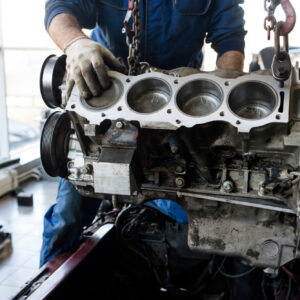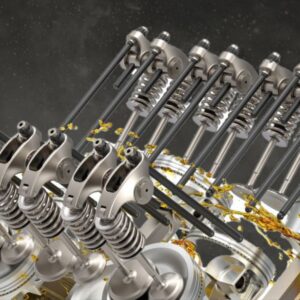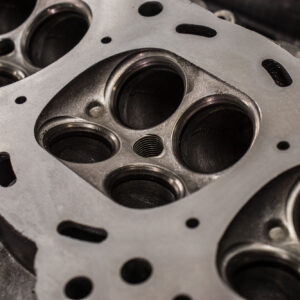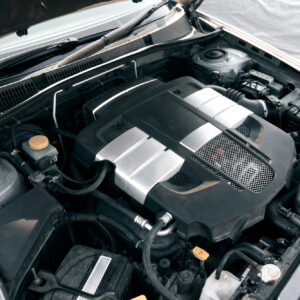The TFSI is one of Audi’s most popular and widely used engines. It plays a key role in the stellar performance of Audi cars and also powers Volkswagen models. But what set it apart from its contemporaries? Let’s take a closer look at the Audi TFSI engine.
TFSI Meaning
TFSI is short for Turbo Fuel Stratified Injection. It’s the first turbocharged direct injection engine. “Stratified” refers to the way the fuel is injected in pulses rather than a straight spray. It’s a catchy moniker for this engine, and while the first-generation 2.0L Audi TFSI and FSI engines primarily use stratified direct injection, they can also operate in homogeneous mode depending on engine load and operating conditions.
The turbocharger boosts power output, while the direct injection fuel system improves the engine’s responsiveness, reduces emissions, and enhances fuel efficiency.
A Brief History of the TFSI Engine
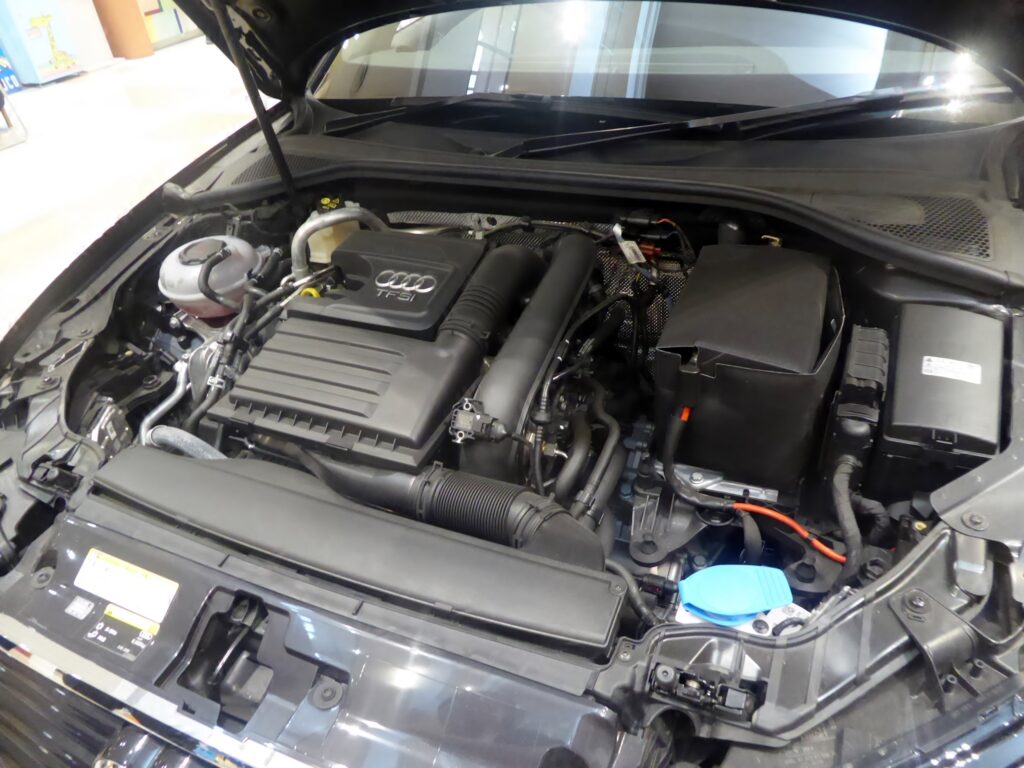
The 2.0 TFSI engine first appeared in 2004. It succeeded Audi’s 2.0 FSI engine and is an enhanced version of the older design.
There are several notable differences between the two Audi engines. The FSI engine uses an aluminum engine block, while TFSI switched to cast iron. Both designs feature 16-valve twin cam cylinder heads, but the TFSI engine replaces the camshafts, valves, and valve springs. Last but not least, the TFSI engine received a turbocharger, vastly improving its power output.
The Audi TFSI engine became so popular that it earned the award for best two-liter engine from 2005 to 2009.
Spurred by success, Audi introduced the 2nd-generation TFSI engine in 2007. Designated EA888, the improved engine was intended for markets outside Europe. Like the 1st-generation, this engine won multiple awards. Modified versions of the EA888 TFSI engine still serve in various Audi and Volkswagen models.
Audi TFSI Versions
Given the TFSI engine’s popularity, it comes as no surprise that the engine came in several variants. Here are the versions of the Audi TFSI engine:
EA113 Audi 2.0 TFSI Engine Versions
The EA113 TFSI engine amassed 11 versions during its production time. Some versions generated 200 hp and 207 lb-ft of torque.
These versions of the TFSI engine powered the Audi A4 B7, Audi A3 8P, and Audi TT. The Volkswagen Golf Mk5 GTI and Volkswagen Jetta Mk5 GLI also used this capable power plant.
Another version of the Audi TFSI engine is the CDL engine. It produced between 220 hp and 265 hp of power and between 251 and 258 lb-ft of torque. The CDL engine powered the Audi S3 (8P), Volkswagen Golf MKVI GTI Edition 35, and VW Golf R.
EA888 Audi 2.0 TFSI Engine Versions
There are 19 versions of the newer EA888 TFSI engine. Two of them are available for US drivers. The first US version is the CCTA/CBFA version, which produces 200 hp and 207 lb-ft of torque. The second one is the CYFB version, which makes 292 hp and 280 lb-ft of torque.
Some of the cars that have this type of engine are:
- Audi Q3
- Audi A3 (8P)
- Volkswagen Golf Mk5 GTI
- Volkswagen Golf Mk6 GTI
- Volkswagen Jetta Mk5 and Mk6
Is the Audi TFSI Engine Good?
The TFSI engine is considered one of the best designs made by Audi. However, it has some serious flaws and requires thorough maintenance.
Common Problems of the Audi 2.0 TFSI Engine
Here are the most common issues of the Audi 2.0 TFSI engine:
- High oil consumption typically due to worn piston rings or PCV system faults.
- Ignition Coil Overheating: Turbocharged engines run hot, and ignition coils are exposed to radiant heat and heat soak issues after engine shut down.
- Cam Follower Wear: The high-pressure fuel pump (HPFP) cam follower can wear through, damaging the camshaft, usually due to the wrong kind of oil being used or extended oil change intervals.
- Timing chain tensioner wear can lead to chain slack and eventual failure.
- Carbon Buildup: Severe intake valve deposits as is common with direct injection.
- PCV valve failure causes boost leaks, rough idle, and oil in the intake tract.
- Diverter Valve Failure: Early diaphragm-style valves tear easily, causing boost loss.
- Oil Pressure Issues: Often linked to balance shaft sprocket or oil pump assembly wear.
Here’s a closer look at some of these issues:
High Oil Consumption
The Audi 2.0 TFSI engine goes through oil rapidly. It can use up to a quart within 1,000 miles, and that’s when the engine is in good condition.
Bad piston rings are the primary culprit behind the TFSI engine’s excessive oil consumption. Audi released a technical bulletin regarding the issue. You need to replace the bad piston rings.
Overheated Ignition Coils
The TFSI engine inherited much from its TSI predecessor. Unfortunately, this included ignition coil failure.
The ignition coils in TFSI and TSI engines tend to overheat. In some cases, engine oil leaking from degraded spark plug well seals seeps into the coils, leading to failure..
When replacing bad ignition coils in your Audi’s TFSI engine, choose an upgraded product with sheathing that protects against high temperatures in the engine bay.
Bad Ignition Coil Connector
Aside from the ignition coils themselves, the parts that join the coils to the wiring harness are also prone to failure. The ignition coil connectors often break their tabs or lose their weather stripping, forcing you to replace them.
Bad Flat Tappet Cam Follower
The Audi TFSI engine’s flat tappet cam follower has been reported to break down easily. Once this happens, the rest of the cam lobe fails soon afterward. A bad cam follower also affects the high-pressure fuel pump, making repairs even more complicated and costly. It’s less of an issue in newer TFSI designs because they switched to a roller cam follower and a more rugged quad lobe.
Bad PCV Valve
As Audi 2.0 TFSI engines put on the years, their PCV valve becomes more likely to fail. A bad valve reduces power output and boost pressure, leading to slower acceleration. It might also trigger a major oil leak.
The earlier EA113 TFSI engine is more likely to develop PCV valve issues. Fortunately, Audi developed a new valve design for later TFSI engines.
Carbon Buildup On Intake Valves
New technologies usually come with unique issues. The TFSI engine introduced direct fuel injection, which sprayed fuel directly into the combustion chamber. While more efficient, it also made the intake valves more prone to clogging.
Carbon gradually builds up on the intake valves, forming gunk that can interfere with the part’s activity. It’s not a problem in port-injected engines because the fuel they spray into the intake manifold also washes over the valves. However, since direct fuel-injected engines don’t do that anymore, the intake valves build up carbon faster.
The intake valves on early gasoline direct injection (GDI) engines are highly vulnerable to carbon buildup. Fortunately, you can prevent this issue with regular intake valve cleaning.
The Audi 2.0 TFSI engine remains a potent design to this day. Keep it in good condition, and you can enjoy driving your Audi for years to come.
Keep Your TFSI Running at Its Best
Owning an Audi with a TFSI engine means driving a car that blends performance and precision. But even the most capable engines need attention over time. Replacing worn ignition coils, fixing a faulty PCV valve, or cleaning intake valves keeps your engine smooth and responsive. Using the right parts matters, especially for engines built with such fine tolerances.
Visit CarParts Euro for quality euro parts all in one place. Whether you drive a Mercedes, BMW, or any other European icon, you’ll find parts from top brands that match your vehicle’s pedigree. CarParts Euro carries precision components for peak vehicle performance, from names trusted by automotive engineers such as Bosch, Meyle, and Continental. Each part fits as it should and delivers the consistency your car was built for.
CarParts Euro is powered by CarParts.com, a trusted name in the automotive parts industry known for dependable service and fast delivery. It’s a straightforward source for Euro car parts in the US, giving you the confidence to keep your vehicle running the way it was meant to.
Any information provided on this Website is for informational purposes only and is not intended to replace consultation with a professional mechanic. The accuracy and timeliness of the information may change from the time of publication.


